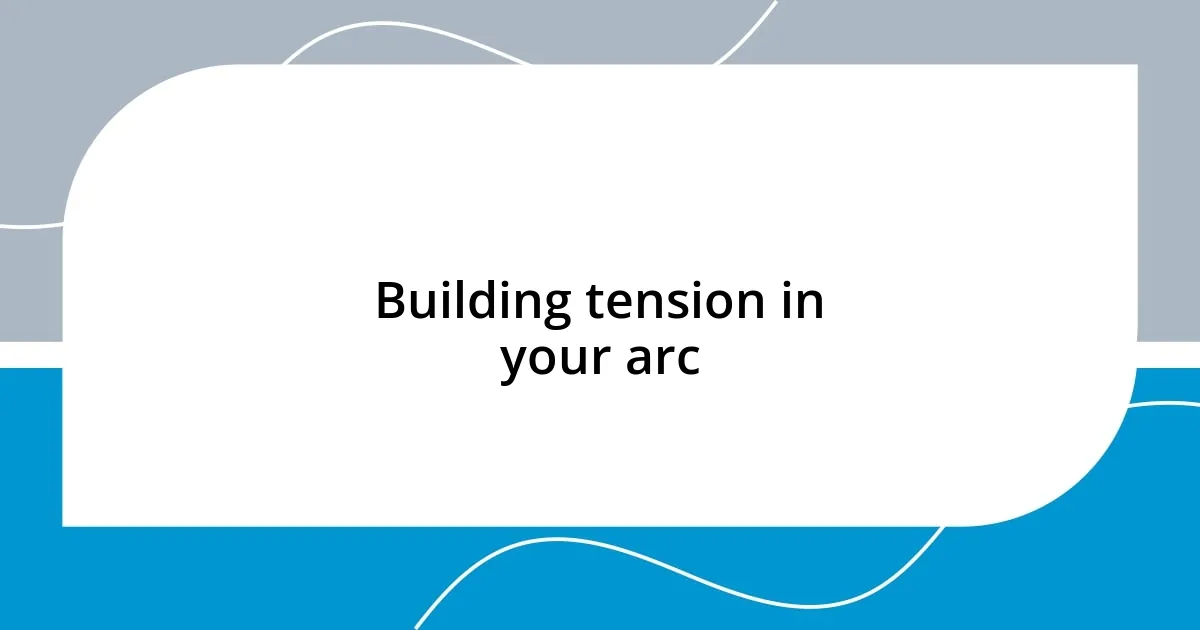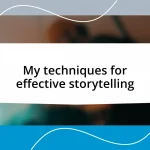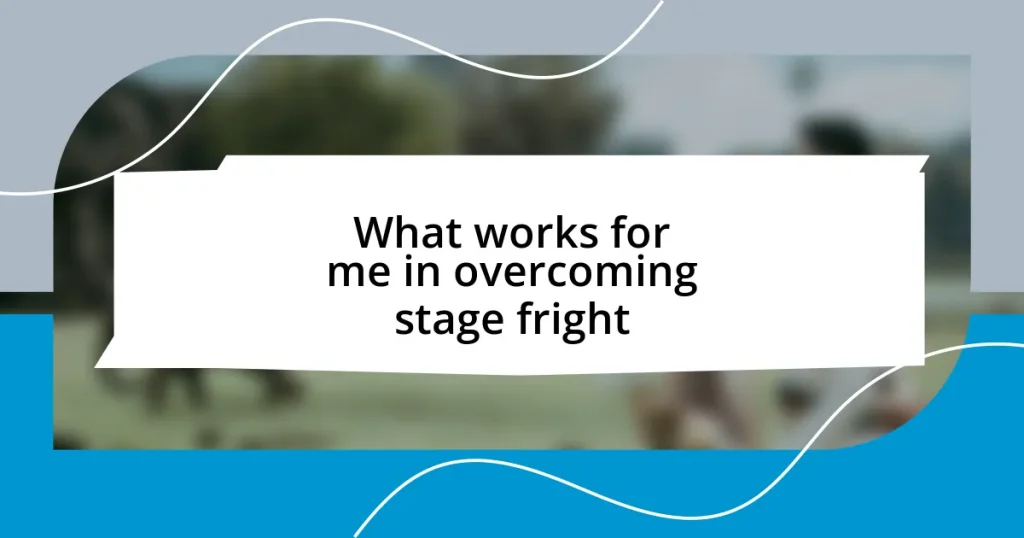Key takeaways:
- Performance arcs create emotional journeys, engaging audiences through rising action, climax, and resolution.
- A strong opening captures attention, sets the tone, and provides context for the audience.
- Building tension enhances engagement through pacing and emotional layering, making climaxes impactful.
- Satisfying resolutions tie together themes and evoke reflection, often including a moment of gratitude to foster connection.

Understanding performance arcs
When I think about performance arcs, I realize they’re like the heartbeat of a story or a presentation. They guide the audience through rising action, climax, and resolution, creating an emotional journey that keeps people engaged. Have you ever noticed how a well-structured performance can invoke unexpected feelings, making you both excited and anxious at the same time?
One time, while delivering a presentation, I felt the energy shift dramatically as I approached the climax of my points. I could see the audience leaning in, their interest piqued. This moment reminded me how essential it is to build tension and release it strategically. Isn’t it fascinating how a well-crafted arc can turn even the simplest message into something impactful?
Understanding performance arcs involves more than just structuring content. It’s about tapping into emotions and crafting relatable moments. I often ask myself what emotions I want to evoke in my audience—curiosity, excitement, reassurance? Recognizing the emotional undercurrents within a performance really enhances its effectiveness. How does this resonate with your experiences?

Importance of a strong opening
A strong opening sets the stage for everything that follows. It’s where you capture your audience’s attention and create an emotional connection right from the start. I remember my first experience delivering a keynote speech; the moment I stepped on stage, I could feel the collective anticipation. My opening line—a surprising statistic—grabbed everyone’s attention instantly. They were curious, and I could see their eyes widen. This pivotal moment transformed the energy in the room.
Here’s why a compelling opening is crucial:
- Grabs Attention: A strong opening captures curiosity and refocuses distractions.
- Sets the Tone: It establishes the emotional atmosphere for the entire performance.
- Provides Context: An effective start gives audience members a framework for understanding the material to come.
Creating that initial spark becomes an inviting pathway for deeper engagement, and it’s always worth investing time to refine those first few sentences. Think of it as an opportunity to not just inform but to resonate emotionally with your audience. Quite a powerful influence, don’t you think?

Building tension in your arc
Building tension is a vital skill when crafting a performance arc. I remember a time during a workshop where I purposefully held back on revealing critical information. The audience was visibly on edge, leaning forward with anticipation. It was exhilarating to watch their expressions change as I teased the crucial moment, allowing the tension to build. This experience taught me that when you create suspense, the payoff is much more satisfying.
In my performances, I often play with pacing to heighten tension. By slowing down my delivery or using well-placed pauses, I make the audience hang on my every word. It’s this artful manipulation of time that can transform a simple statement into a moment of suspense. Have you ever noticed how a brief silence can amplify what comes next? This technique invites curiosity and engagement, making the resolution feel earned.
To effectively build tension, it’s essential to blend different emotional layers. I’ve learned to weave in moments of conflict or stakes, which can resonate deeply with the audience. For instance, sharing a personal story of a challenge I faced allows the audience to connect emotionally. As they empathize, the tension naturally intensifies, creating a more immersive experience. This journey of tension isn’t just about leading to the climax; it’s about crafting a meaningful connection throughout.
| Technique | Description |
|---|---|
| Building Suspense | Delaying key information to create anticipation. |
| Playing with Pacing | Using pauses and varied speeds to heighten engagement. |
| Emotional Layering | Integrating personal stories to connect and intensify tension. |

Creating a climax that resonates
Creating a climax that resonates involves crafting a moment that feels significant and impactful. I recall a presentation where I built up to a pivotal conclusion about the power of resilience. The room was filled with eager faces, and as I paused before sharing the final revelation, I felt the weight of anticipation hanging in the air. This moment wasn’t just about the information; it was about connecting deeply with my audience’s desires and experiences, allowing them to feel like they were part of the journey.
Drawing on relatable themes can echo in your audience’s hearts, ensuring the climax resonates long after the performance is over. One time, when sharing a personal failure, I noticed the energy shift; heads nodded in understanding, and quiet murmurs reflected their own experiences. It became clear to me that when we share vulnerabilities, we tap into shared human emotions. Isn’t it incredible how a well-timed story can unite a room and create a collective sigh of recognition?
Finally, I’ve learned that visual and emotional cues can amplify the climactic moment. During a particularly passionate segment, I decided to project an image that encapsulated my message. The visuals combined with my heartfelt delivery tugged at the audience’s emotions, making that climax not just a point of information, but a shared experience. Remember, the goal is to leave your audience feeling something profound. Wouldn’t it be amazing to create moments that linger in their minds, sparking conversations long after you’ve stepped off the stage?

Techniques for a satisfying resolution
Achieving a satisfying resolution often hinges on tying up loose ends in a way that feels both impactful and genuine. I remember wrapping up a performance with a call to action that resonated strongly with my audience. Instead of simply restating my main points, I posed a question that challenged them to reflect, “What will you do differently tomorrow?” This not only provided closure but also inspired them to carry the message forward.
In my experience, echoing themes established earlier in the performance helps reinforce a satisfying resolution. For instance, during a storytelling session about overcoming obstacles, I concluded by revisiting the initial challenge I faced, weaving it into my final thoughts. It was a moment of recognition that tied everything together, prompting smiles of understanding and a sense of camaraderie. It leaves the audience feeling that they, too, have journeyed with me, which is profoundly rewarding.
Additionally, I find that incorporating a moment of gratitude as a final touch can elevate the resolution. After sharing a particularly emotional story about support from mentors, I took a brief pause to thank my audience for being part of the experience. It’s incredible how that simple act of acknowledgment can create a lingering warmth in the room, making everyone feel valued. Have you ever felt that surge of connection when someone expresses genuine appreciation? It’s a powerful way to close any performance on a high note.

Evaluating your performance structure
When evaluating your performance structure, I find it essential to examine how each segment flows logically into the next. I once revisited a presentation where the transition from one key idea to another felt shaky. I realized that by tightening these connections, I could maintain the audience’s engagement and ensure they easily follow my thought process. Have you ever felt lost during a speech due to abrupt changes? It’s a feeling I strive to avoid.
Another important aspect is assessing the pacing of your performance. I vividly remember a time when I rushed through a particularly critical section, eager to make a point. The result? I noticed my audience overwhelmed, struggling to absorb the information. Slowing down during key moments not only enhances comprehension but also builds anticipation. Isn’t it fascinating how a shift in tempo can transform an experience?
Lastly, gathering feedback from trusted peers can illuminate blind spots in your structure. After one session, a colleague pointed out that I hadn’t fully fleshed out a critical argument. Their insight helped me realize how vital it is to ensure each point is not only presented but also explored in depth. Have you ever had that lightbulb moment when someone else’s perspective opened your eyes to new possibilities? In my experience, these external insights can significantly elevate the effectiveness of your performance arc.

Tips for continuous improvement
One effective tip for continuous improvement is to embrace a mindset of experimentation. I once decided to test out a new interactive segment in my performance, where I invited audience members to share their thoughts in real-time. Initially, I felt nervous about how it would unfold, but the energy in the room transformed dramatically, sparking incredible conversations that enriched the entire experience. Have you ever tried something new and felt that thrill of connection with your audience? It’s a testament to how stepping out of your comfort zone can lead to amazing breakthroughs.
Another crucial aspect is setting aside time for reflection after each performance. I recall a particularly intense show where I felt a mix of exhilaration and uncertainty. Instead of rushing into planning my next event, I took a few moments to jot down my thoughts immediately after. This practice revealed valuable insights I might have overlooked otherwise, like the responses I received to certain stories. Have you ever had those “aha” moments when you reflected on how your delivery affected your audience? It’s these insights that fuel continuous growth.
Engaging in peer reviews can significantly enhance your performance skills. I remember reaching out to a fellow performer after a presentation. Their candid feedback about my delivery style opened my eyes to nuances I’d been blind to, like my pacing and use of silence. Isn’t it amazing how someone else’s perspective can shed light on areas we might need to work on? Those conversations can carve the path to improvement and foster a community of support that benefits everyone involved.
















